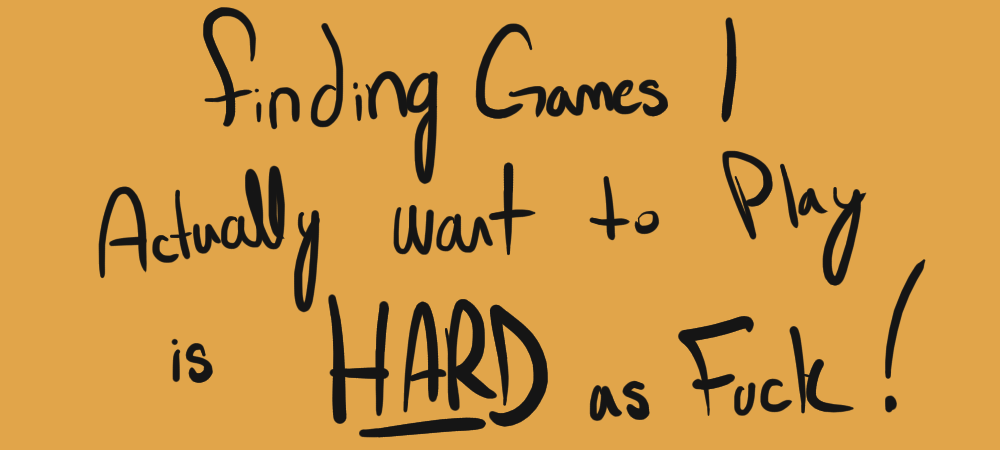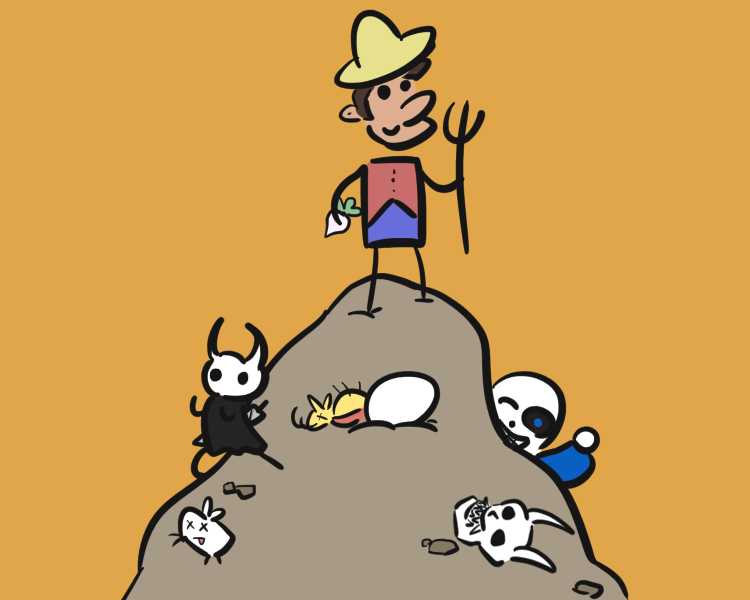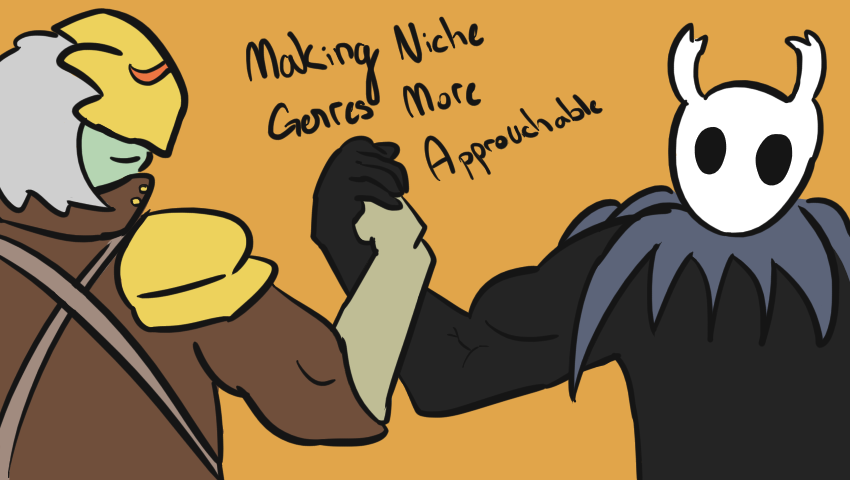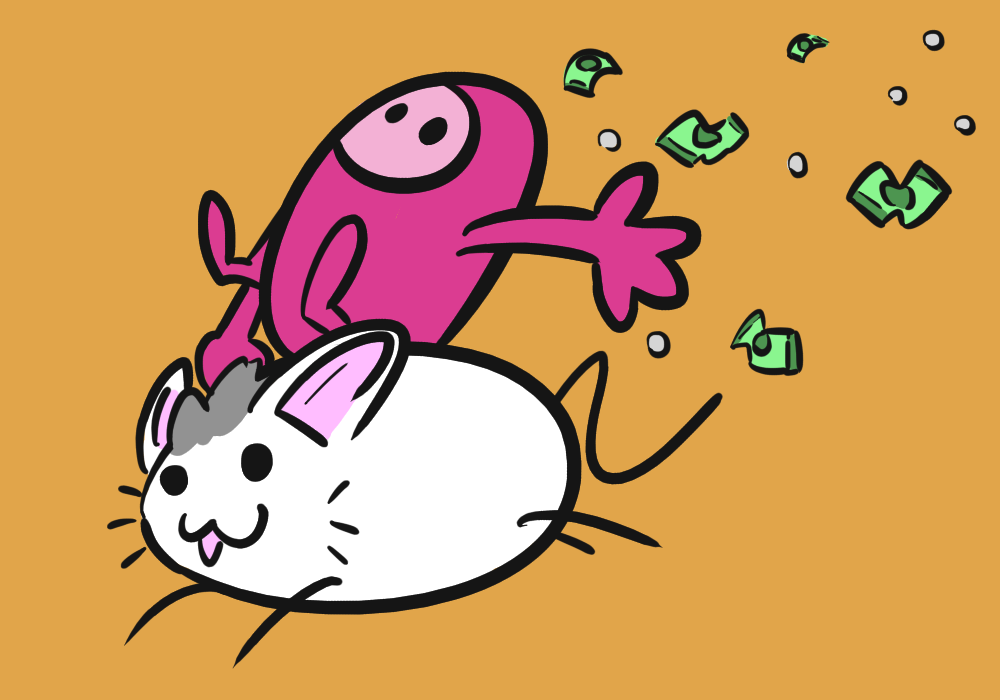I’ve been thinking a lot about game discoverability lately. This all started a couple weeks back when the popular (infamous?) Youtuber Videogamedunkey launched an indie publishing label called Big Mode. I have some thoughts on that, but ultimately concluded that I’m glad it exists. If Dunkey can help even one game to find an audience it otherwise wouldn’t then the whole thing will have been a net positive.
That brings me to what’s actually been cycling through my head for the past 2 weeks:

I’m aware that’s a truly enlightened take. However, over the past decade I’ve found it increasingly difficult to discover games I actually want to play. There is no short supply of new games hitting the market every single day, even if the big companies are putting out fewer titles. Just look at Steam – thousands of new games are released every week. Not everything is worth playing, but the point remains: there is no shortage of new experiences to play.
The issue isn’t one of availability – it’s one of discoverability. If you’re a new game releasing in today’s market you have the unfortunate task of competing with thousands of other games. This can make standing out of the crowd an insurmountable task. I know it’s common practice to point to a handful of indie success stories over the past several years, but all of those games have something in common: broad appeal. If you appeal to a wide audience, then you’re likely to find that audience once word of mouth picks up.

To illustrate my point we can look at Slay the Spire, which I’m only using as an example because I’m quite familiar with it. A big part of its success stems from how approachable it is compared to other deck-building games. The main draw of this genre is using synergies – playing 2 or more cards to exponentially increase the effectiveness of each card played. Slay the Spire makes this so simple that first time players are likely to bumble into finding them without even knowing the full array of available cards. This lower barrier to entry allowed Slay the Spire to pull in many players, despite catering to the deck-building niche.
A similar phenomenon happened with Hollow Knight, which addressed the major problem most players have with Metroidvania titles: backtracking. People don’t enjoy having to go through all the shit they’ve already been through looking for the one thing they need to move forward. Hollow Knight addressed this by featuring non-linear levels shortly after the tutorial. Players are given several valid paths to make forward progression, meaning they aren’t as likely to run into roadblocks while exploring. Thus, far more people stuck with Hollow Knight, and now it has an annoyingly large fanbase that loses their collective shit every time a Nintendo Direct goes by without announcing a release date for the Hollow Knight sequel.

Those are just 2 examples, but I’m sure you can think of others. Fact is, games with broad appeal tend to get their name out there a lot more easily then more niche titles. I’m positive that everyone reading this will have heard of both Slay the Spire, and Hollow Knight. I couldn’t say the same for Monster Train, and Ender Lilies – both of which I’ve covered on here before. Those latter games are far more niche in their appeal, and thus weren’t necessarily as successful as the former examples.
So if you want to make a game with a more niche appeal what options are you left with? Well you could advertise the pants off your game. There’s no short supply of success stories thanks to heavy advertising. 2 recent examples that come to mind are Fallguys, and Stray. Both were advertised heavily prior to their release: the former by its publisher, while Sony pushed the latter. This undoubtedly put the games in front of millions of eyes, and ultimately led to both releasing to monstrous successes.

Thing is – neither of those games are particularly niche. The former, Fallguys, was a casual party game released during the global pandemic – a time when we all needed a light-hearted distraction. The latter, Stray, is a game about being a cat. That idea basically sells itself. People love cats. I’m not going to say there was no risk in backing these games, but the publishers behind them had substantially less risk than they’d have advertising something like Them’s Fightin’ Herds, or Crosscode.
Yes – unfortunately, indie games have long since moved past the point where you can simply make a quality title, and have it be successful upon release. There are so many games coming out that your game might be suffocated into submission, never finding its intended audience.
I think that’s a bit of a shame. Selfishly, I wish it was easier to find the titles that uniquely appealed to me. Hell, I wish it was easier for everyone to find titles they were interested in. There’s no way I’m the only person who’s had this thought about it being harder to find games they’re interested in playing.

This all brings me back around to Big Mode. I’ve watched Dunkey’s goofy videos for years now. I don’t always agree with his take on things, but I have found a couple of games I otherwise wouldn’t have thanks to him. Big Mode is going to be yet another voice screaming for our attention, but I don’t see another way around this problem. Hopefully it is able to boost a deserving game to find the audience it was made for. Lord knows it isn’t getting any easier.

Reblogged this on DDOCentral.
LikeLike
I’m not always on board with Dunkey’s takes either but I agree — also think he’s genuine despite all his shitposting (or maybe the shitposters are sometimes the most genuine?) I hope he can do some good with this new label.
I haven’t had such problems finding new games I’d probably like in the niche VN and Japanese/Japanese-influenced areas, but these tend to have dedicated publishers like Henteko Doujin and Mangagamer. When it comes to indie games generally, discoverability is definitely a problem. I like to dig on itch.io sometimes, but that’s really like digging through a trash heap with some treasures in it — you have to search through some crap before you get to the good stuff, and sometimes it’s not obvious whether you’ve actually hit something good or not until you play it.
LikeLiked by 1 person
I can really relate to that feeling if being unable to find new but good shit, as well as how some of your favorite I did games are stuck in obscurity for one reason or another.
Some fangames like Rayman Redemption and SRB2Kart definitely deserve a lot more love out there, though they did have huge spikes of popularity at first; Redemption because it’s a fixed and improved Rayman 1, and Kart because it has been 4 years since it launched and was played by Lythero and Vinesauce Vinny. But there also stuff like Mega Man Maker, Toy Tanks (basically a Wii Tanks inspired game), that game with a blue blob that could swing around levels with it’s tongue (I forgot the name but the demo was fun), etc. I know I mixed fangames and indie games… but I haven’t really found new highlights to mention like you did (like Crosscode)
The latest one I have an eye on is Aero GPX; it has been covered already in Nintendo websites since it’s basically an F-Zero spiritual successor and has got halfway through its funding…but I haven’t seen it get THAT much word of mouth around either, despite the demo being released for everybody to try it. But Lythero did stream it yesterday, so probably more people will start finding out sooner…
Anyways, dunkeys big mode is a cool thing to see from him; loved his videos and sounds very promising from the idea of putting a highlight on new stuff worth checking out is really cool coming from the dunk himself
LikeLiked by 1 person
F-Zero is never a series I ever got into, but if what you’ve said about Aero GPX is true then I’ll have to let one of my buddies that is a big fan of F-Zero know about it. He’s been (silently) demanding Nintendo release a new one for ages, but I think a spiritual successor is likely as good as anyone will get. Not that there’s necessarily a problem with that – aside from the fans figuring out about the new game.
Also I think the blue blob tongue game you described is Crumble?
Steam page: https://store.steampowered.com/app/1061180/Crumble/
LikeLike
Yep, that one!
Also, today I started checking my Twitter account to clear some follows I had, but between those I’m likely finding some cool games in it from the devs I was following, like Frogun and Rusted Moss (the latter had caught my eye but only today I learned it had a demo on Steam too)
And he’s definitely gonna be hyped about Aero GPX (also tell him about Turbo Force by Panzer too; it also was available on playtest on Steam but no idea if that’s still open or not)
LikeLiked by 1 person